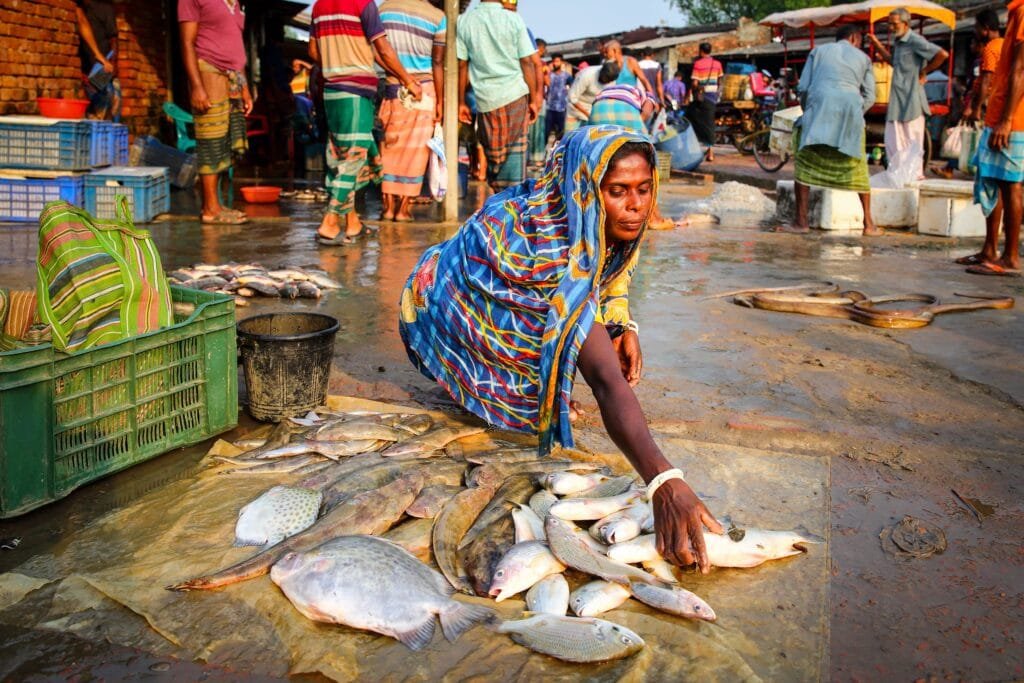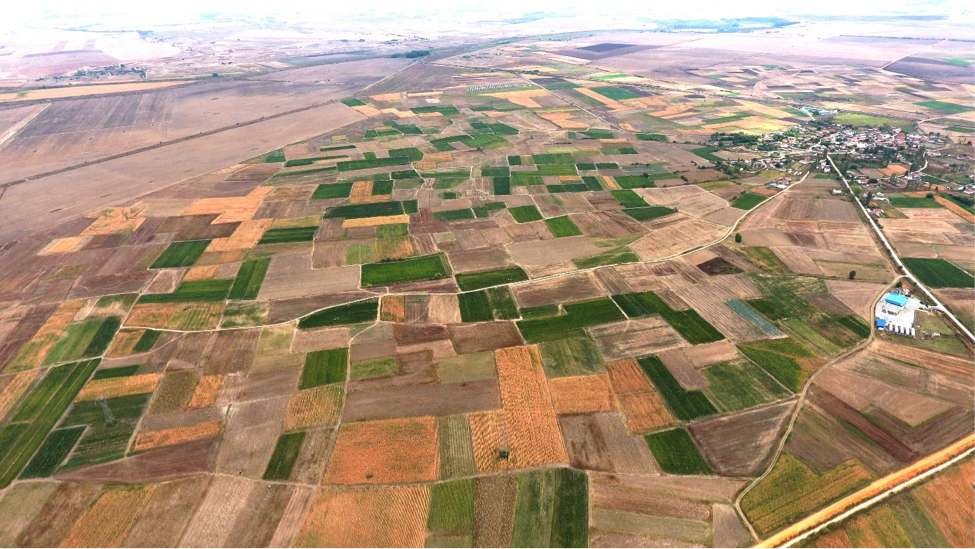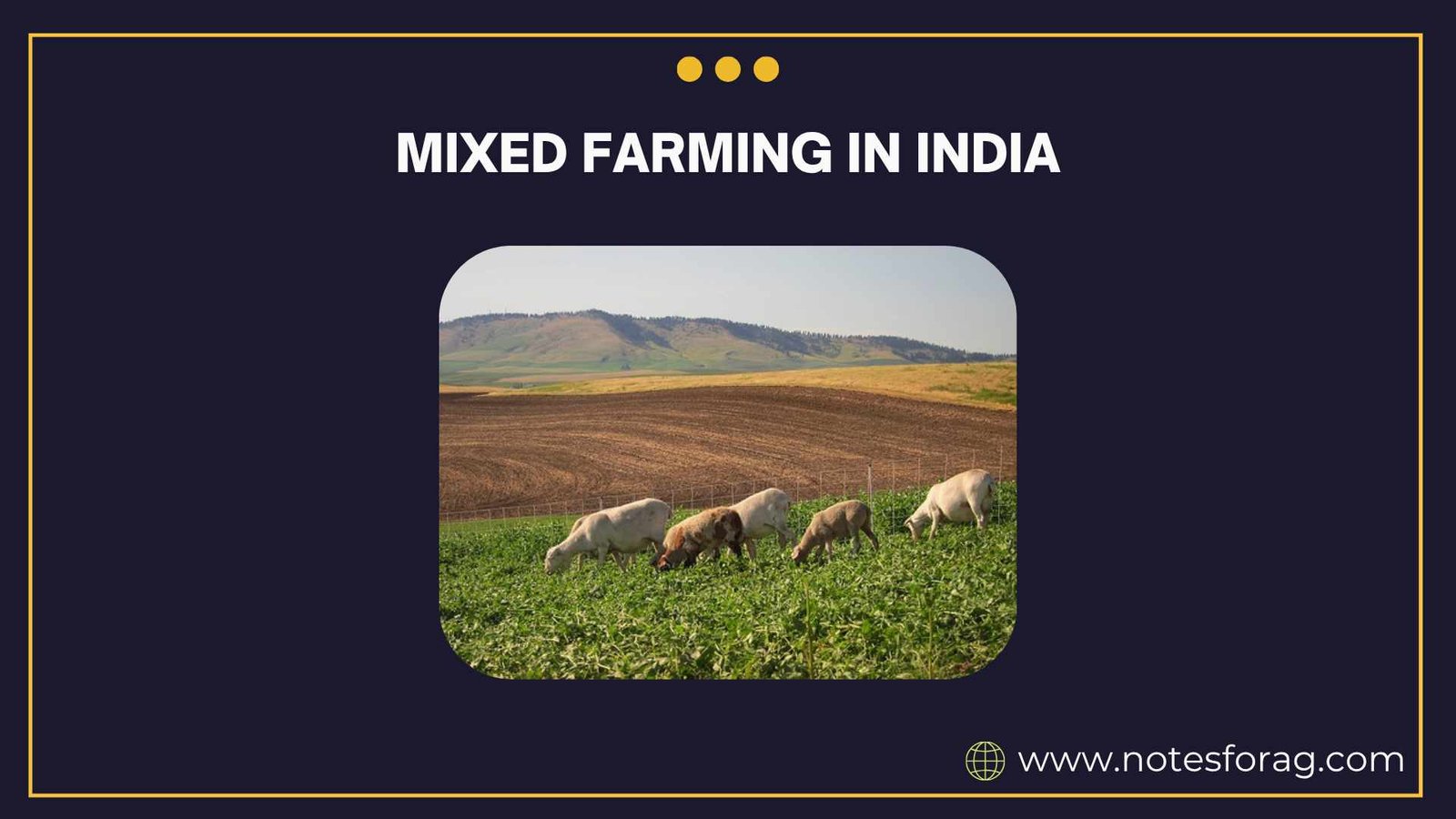1. INTRODUCTION TO MIXED FARMING IN INDIA
Mixed farming in India is an agricultural system where farmers cultivate crops and raise animals simultaneously on the same piece of land. This integrated approach allows farmers to maximize resource utilization, diversify their income, and reduce risk from crop failures or market fluctuations. In India, mixed farming is a traditional and widely practiced system, especially among small and marginal farmers. It supports food security, economic stability, and sustainable farming.
The concept of mixed farming promotes a balanced interaction between crop production and livestock rearing, where each complements the other. Crop residues become feed for animals, and animal manure enriches the soil for better crop yields. This cyclical flow enhances productivity and contributes to ecological sustainability.
Table of Contents
2. IMPORTANCE OF MIXED FARMING IN INDIA
The importance of mixed farming in India are,
2.1 Diversification of Income Sources
Mixed farming in India provides farmers multiple revenue streams. If crops fail due to drought or pests, income from livestock such as milk, meat, or eggs can sustain the household. This diversification is particularly important for small-scale farmers who depend entirely on agriculture for livelihood.
2.2 Efficient Resource Utilization
By combining crops and livestock, farmers make full use of farm resources. For example, crop residues such as straw and husk feed animals, while animal dung serves as natural fertilizer. This reduces waste and the need for chemical inputs, promoting organic and sustainable farming practices.
2.3 Soil Fertility and Environmental Benefits
Animal manure improves soil structure and fertility by adding organic matter and essential nutrients. This reduces soil erosion, increases water retention, and maintains soil health over time. Mixed farming also enhances biodiversity by supporting various plants and animals on the farm.
2.4 Food Security and Nutrition
Mixed farming produces a variety of food products including cereals, vegetables, dairy, and meat. This variety improves the nutritional intake of farming families and local communities, contributing to better health outcomes.
2.5 Risk Management and Economic Stability
In case of crop failure due to natural calamities or market price drops, income from livestock or alternative crops provides a financial cushion. This risk reduction is essential for farmers’ economic resilience.
3. TYPES OF MIXED FARMING IN INDIA
The Types of Mixed farming in India ,
3.1 Crop-Livestock Mixed Farming

This is the most prevalent form of mixed farming in India. Farmers grow crops such as rice, wheat, maize, pulses, or oilseeds alongside raising livestock like cattle, buffalo, goats, sheep, or poultry. Livestock provides milk, meat, manure, and draft power, while crops provide fodder and feed.
This system is especially common in states like Punjab, Haryana, Uttar Pradesh, and Maharashtra, where fertile soils and better irrigation support both crops and animals.
3.2 Crop-Horticulture and Livestock Farming
In this system, horticultural crops such as fruits and vegetables are grown alongside livestock rearing. Regions like Himachal Pradesh, Uttarakhand, and parts of Tamil Nadu practice this. Fruit orchards, vegetables, dairy animals, and poultry coexist, increasing income diversity and land productivity.
3.3 Crop-Fish-Livestock Mixed Farming
Some farms integrate fish culture in water bodies along with crop cultivation and animal husbandry. This is common in Kerala, West Bengal, and Assam where water resources are abundant. Fish farming provides additional protein source and income, complementing crops and livestock products.
3.4 Agroforestry Combined with Livestock
Agroforestry involves growing trees alongside crops and animals. In this system, farmers benefit from timber, fruits, fodder, and shade for animals. Trees also help control soil erosion and improve microclimates, benefiting crop and animal production.
4. COMPONENTS OF MIXED FARMING IN INDIA
The components of mixed farming in India,
4.1 Crop Production
Crop production forms the backbone of mixed farming. Farmers cultivate a variety of crops based on the region’s climate, soil type, and water availability. Common crops include cereals like rice, wheat, maize, and millets; pulses such as lentils and chickpeas; oilseeds like mustard and groundnut; and various vegetables and fruits. The selection of crops is critical to ensure continuous availability of fodder and feed for livestock. After harvesting, crop residues such as straw and husks are not wasted; instead, they serve as valuable feed and bedding material for animals. This efficient utilization of crop by-products supports the livestock component and reduces farming costs.
4.2 Animal Husbandry
Livestock rearing is the second major component of mixed farming, providing crucial products such as milk, meat, eggs, manure, and draft power. Commonly reared animals include cattle, buffalo, goats, sheep, pigs, and poultry. Animals not only offer nutrition but also generate additional income for farmers. Proper management of livestock, including feeding, healthcare, breeding, and shelter, is vital to maintain productivity. Animals convert farm waste into valuable manure, which improves soil fertility for crop cultivation. Additionally, draft animals assist in ploughing and other farm operations, reducing dependency on machinery.
4.3 Fishery (Where Applicable)

In regions rich in water resources, fish farming is integrated into mixed farming systems. Ponds, tanks, and small water bodies are used for cultivating fish alongside crops and livestock. Fish farming provides a high-protein food source and additional income. The presence of fish also helps in nutrient recycling in the water ecosystem. Fish waste enriches water bodies, which can be used to irrigate crops, creating a sustainable nutrient cycle.
4.4 Inputs and Resources
Effective mixed farming requires the careful management of inputs such as quality seeds, organic or chemical fertilizers, animal feed, water, veterinary services, and labor. The availability and affordability of these inputs influence the overall success of mixed farming. Water management is especially important, as both crops and livestock depend on adequate and timely irrigation and drinking water. Farmers also need access to agricultural knowledge and technology to optimize input use and maintain farm sustainability.
5. ADVANTAGES OF MIXED FARMING IN INDIA
The advantages of mixed farming in India,
5.1 Income Stability
Mixed farming reduces the risks linked to depending on a single source of income. If crops fail due to pests, drought, or floods, livestock products such as milk, meat, and eggs provide an alternative income. This financial stability helps farmers meet their daily needs and invest in their farm for future growth.
5.2 Increased Productivity
The reciprocal relationship between crops and animals boosts overall farm productivity. Crop residues serve as animal feed, while animal manure enriches the soil, leading to better crop yields. This synergy helps farmers achieve higher production on limited land, making the farm more productive and sustainable.
5.3 Sustainable Agriculture
Mixed farming reduces reliance on chemical fertilizers and pesticides by promoting organic manure and natural pest control through biodiversity. This approach helps conserve the environment by protecting soil health, maintaining water quality, and supporting wildlife habitats on the farm.
5.4 Employment Generation
This diversified farming system creates more jobs on farms. Labor is needed for planting, harvesting, animal care, feeding, milking, and other related activities. This is particularly important in rural India, where agriculture remains the main source of livelihood.
5.5 Food and Nutritional Security
Producing a variety of crops and animal products on the same farm ensures that farmers and their families have access to a balanced and nutritious diet. This diversity helps reduce malnutrition and improves health outcomes in rural areas.
6. CHALLENGES IN MIXED FARMING IN INDIA
The challenges in mixed farming in India,
6.1 Fragmented Land Holdings

Most Indian farmers operate on small and fragmented plots of land. This fragmentation limits the ability to adopt mechanized farming and efficient large-scale mixed farming. Small plots may also restrict the integration of multiple enterprises due to limited space.
6.2 Limited Access to Technology and Inputs
Many farmers lack access to improved seeds, quality animal breeds, veterinary services, and modern equipment. This limits their ability to enhance productivity and efficiently manage both crops and livestock.
6.3 Knowledge and Skill Gaps
Managing crops and animals together requires diverse skills and technical knowledge. Many farmers, especially smallholders, may not have access to proper training or extension services, leading to suboptimal management and productivity losses.
6.4 Market and Infrastructure Issues
Poor infrastructure such as roads, storage facilities, and market linkages makes it difficult for farmers to sell their products at good prices. Limited access to credit and insurance further increases their vulnerability to losses.
6.5 Environmental Factors
Climate change, unpredictable weather patterns, droughts, floods, and pest outbreaks affect both crops and livestock. These environmental stresses increase the risk of production losses and reduce farm sustainability.
7. GOVERNMENT SUPPORT AND INITIATIVES FOR MIXED FARMING IN INDIA
7.1 Extension Services and Training
The government and agricultural institutions provide training programs and extension services to educate farmers about integrated farming practices, animal health management, and improved crop cultivation techniques. These programs help farmers increase productivity and adopt sustainable practices.
7.2 Subsidies and Credit
Various subsidies on seeds, fertilizers, animal feed, and equipment make it easier for farmers to invest in mixed farming. Affordable credit facilities and loans from government banks support farmers in expanding their farming enterprises.
7.3 Insurance Schemes
Crop and livestock insurance schemes protect farmers against losses caused by natural calamities, disease outbreaks, or market fluctuations. These schemes provide financial security and encourage farmers to take risks for better returns.
7.4 Research and Development
Research organizations such as the Indian Council of Agricultural Research (ICAR) and State Agricultural Universities develop improved crop varieties, fodder crops, and high-yielding livestock breeds. They also work on pest control, disease management, and farm mechanization suitable for mixed farming.
7.5 Promotion of Integrated Farming Systems
Government policies encourage the adoption of integrated farming systems that combine crops, livestock, fishery, and agroforestry. These systems increase resilience, diversify income, and promote sustainable agricultural development.
8. REGIONAL VARIATIONS IN MIXED FARMING IN INDIA
8.1 Northern Plains
The fertile alluvial soils and abundant irrigation facilities of the Northern Plains support intensive crop-livestock mixed farming. Farmers here grow wheat, rice, sugarcane, and pulses, alongside dairy farming and poultry. The Green Revolution also enhanced productivity in this region.
8.2 Western India
In the semi-arid and arid zones of Rajasthan and Gujarat, mixed farming adapts to water scarcity by growing drought-resistant crops such as millets and pulses, combined with hardy livestock like goats and sheep. These animals are better suited to harsh climatic conditions and provide meat, milk, and wool.
8.3 Eastern India
States like West Bengal, Bihar, and Odisha have water-rich environments that support rice cultivation combined with fish farming and livestock rearing. Floodplains and wetlands provide ideal conditions for integrated crop-fish-livestock farming, which improves farmers’ income and nutrition.
8.4 Southern India
The southern states, including Tamil Nadu, Karnataka, and Kerala, practice mixed farming that integrates horticulture crops (fruits, vegetables, spices) with dairy and poultry farming. Coastal areas add fishery to the mix, taking advantage of abundant water and marine resources.
8.5 Northeastern India
The diverse agro-ecological zones of the Northeast, with high rainfall and hilly terrain, support traditional mixed farming including shifting cultivation (jhum), livestock, and fishery. These systems are adapted to local environments and tribal communities’ needs.
9. FUTURE PROSPECTS OF MIXED FARMING IN INDIA
Mixed farming offers a promising pathway for sustainable agriculture in India’s future. With increasing population pressure on land and changing climate conditions, integrated farming systems will become even more important for ensuring food security and livelihoods.
Adopting modern technologies such as precision farming, improved animal genetics, digital advisory services, and mechanization can boost efficiency and profitability. Climate-resilient crops, water-saving irrigation, and organic farming practices can make mixed farming more environmentally friendly.
Government support, market reforms, and value addition through agro-processing industries will enhance income from mixed farming. Promoting farmer cooperatives and rural entrepreneurship linked to mixed farming can empower small farmers economically and socially.
Education, training, and extension services will remain crucial to build farmer capacity and innovation adoption. Overall, mixed farming has the potential to transform Indian agriculture into a more diversified, resilient, and sustainable sector, benefiting millions of farmers and the nation’s food system.
Conclusion
Mixed farming in India is a time-tested, sustainable agricultural system that integrates crop cultivation and livestock rearing on the same farm. In India, where the majority of farmers are smallholders with limited land, mixed farming plays a crucial role in ensuring food security, income diversification, and environmental balance. By efficiently utilizing resources such as crop residues and animal manure, mixed farming enhances soil fertility, reduces waste, and promotes ecological sustainability. The system also helps farmers manage risks by providing multiple income sources, which is essential given the uncertainties of climate, markets, and pests.
Despite its many benefits, mixed farming faces challenges like fragmented landholdings, limited access to modern technology and inputs, and inadequate market infrastructure. Addressing these issues through government support, research, extension services, and financial schemes can boost productivity and farmer welfare. Regional variations in India show how mixed farming adapts to local environmental and socio-economic conditions, making it a flexible and resilient model.
Looking ahead, the future of mixed farming in India looks promising with advancements in improved crop varieties, animal breeds, precision farming, and digital technologies. Integrating climate-resilient practices and strengthening farmer cooperatives will further empower rural communities. As India strives to meet the food demands of its growing population, mixed farming stands out as a vital approach to sustainable and inclusive agricultural development. It balances productivity with ecological health and offers small farmers a viable pathway to prosperity and resilience in an ever-changing agricultural landscape.
Frequently Asked Questions (FAQs)
What is mixed farming?
Mixed farming is an agricultural practice where crops and livestock are raised together on the same farm. It helps farmers use resources efficiently and earn income from multiple sources.
What is mixed farming state its two chief features?
Mixed farming is the combination of crop cultivation and animal husbandry on one farm. Two main features are crop and livestock integration, and efficient use of farm resources.
What is mixed farming system?
A mixed farming system involves growing crops and rearing animals together to improve farm productivity and sustainability. It promotes balanced income and better use of natural resources.
Related Articles

